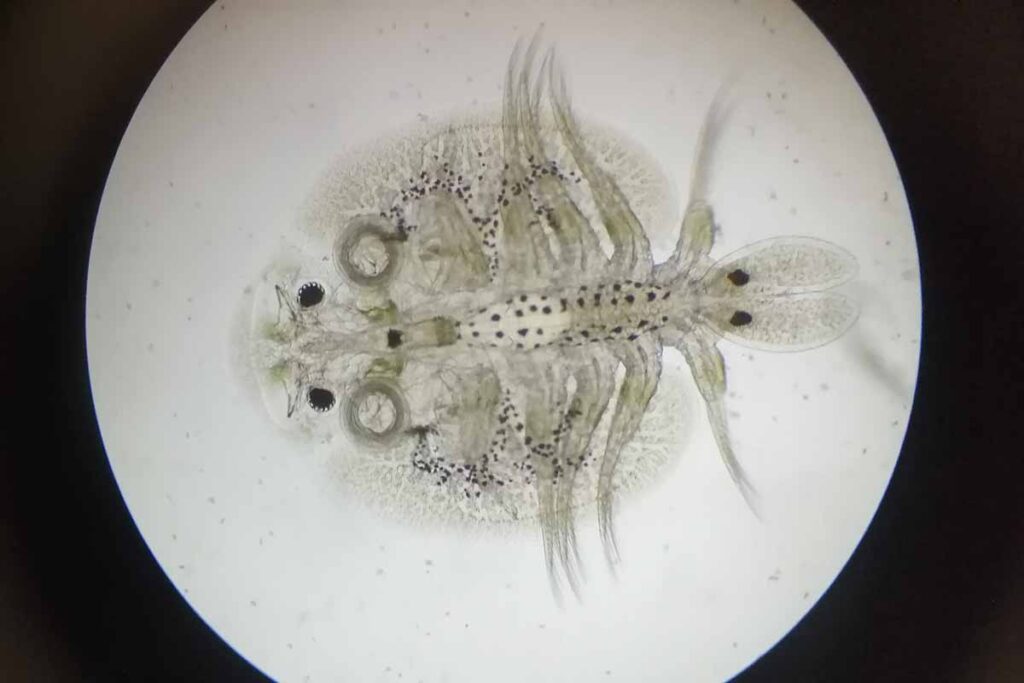Imagine your pet fish suddenly sporting unwelcome hitchhikers – tiny, creepy crawlies clinging to its fins! That’s the nightmare of fish lice, also known as Argulus. These uninvited guests aren’t just annoying, they can seriously harm your finny friends.
But don’t worry, this guide is your weapon against these pesky parasites. Fish lice are like underwater vampires, sucking the blood and energy out of your fish. Left unchecked, they can weaken your pets, making them more prone to diseases and even death. That’s why it’s super important to spot them early and take action!
In this guide, We’ll help you identify these nasty critters, explore safe and effective ways to treating fish lice, and even teach you how to prevent them from ever showing their ugly faces again! So grab your nets and metaphorical magnifying glasses, it’s time to save those fishy friends!
What Are Fish Lice?
Fish lice, also known as Argulus, are tiny parasitic crustaceans that can wreak havoc on fish health. These pesky creatures typically have an oval-shaped body with several pairs of legs and a pair of large, piercing mouthparts.
They latch onto fish by attaching themselves to the skin, scales, or fins, where they feed on blood and tissue fluids. Fish lice undergo several stages in their life cycle, including egg, larva, nymph, and adult. Each of these stages poses a threat to fish health. Various species of fish are vulnerable to lice infestations, including both freshwater and marine species.
While some fish may be more susceptible than others, all fish are at risk if exposed to infested water sources. Understanding the appearance, behavior, and life cycle of fish lice is crucial for effectively identifying and treating infestations. So, we can ensure the well-being of our aquatic companions.
Symptoms Of Infestations To Be Noted Before Treating Fish Lice
There are a number of symptoms that may indicate there is a fish lice infestation. They are:
- Erratic swimming: Is your fish darting around like a pinball, zooming erratically, or just not swimming smoothly? This could be due to itchiness caused by lice.
- Flashing: Rapidly darting back and forth is another sign your fish might be trying to scratch an itch.
- Rubbing: Does your fish seem to be rubbing against decorations or the tank walls more than usual? This could be them trying to relieve irritation from lice.
- Spots and patches: Keep an eye out for white spots, red patches, or even open sores on your fish’s body. These can be signs of lice feeding on their skin and mucus.
- Torn fins: Damaged or ragged fins can be a sign of lice irritation and biting.
- Clamped fins: If your fish keeps its fins pressed close to its body, it might be trying to protect them from lice.
- Mucus overload: A sudden increase in slime production can be your fish’s way of protecting itself from lice irritation.
Not every fish with these symptoms will have lice, but they’re good indicators that something might be wrong. If you notice any of these signs, it’s best to consult a pet store employee or veterinarian for further advice and treatment options.
Treating Of Fish Lice
Here’s how to treat those pesky fish lice and get your aquarium back to a happy, healthy place:
1. Quarantine Time
Think of it like fish jail! Isolating infected fish in a separate tank is crucial to stop the lice from spreading to their buddies. Remember, lice can hitchhike on plants and decorations too, so disinfect those before adding them to the quarantine tank. Thus treating fish lice in this way is effective.
2. Medicine Mission
Time to choose your weapon for treating fish lice! Depending on the severity of the infestation and your fish’s species, several treatment options are available:
- Medicated baths: Think spa day for your fish! Short dips in medicated solutions can target and kill lice. Follow instructions carefully as some medications can be harsh.
- Dips: Quick dunks in special solutions can be effective for mild infestations. Choose dips specifically designed for fish lice and be gentle during handling.
- Anti-parasitic meds: These come in various forms, like flakes or tablets, and target lice internally. Consult your pet store or vet for the right medication for your fish type.
Important Note: Always follow dosage instructions carefully and never mix medications without expert advice. Overdosing can harm your fish!
3. Natural Remedies
Looking for a greener approach to treating fish lice? Consider these eco-friendly options:
- Salt treatment: Adding a small amount of aquarium salt (not table salt!) to the tank can create an environment uncomfortable for lice. However, some fish are sensitive to salt, so research first.
- Garlic extract: Studies suggest garlic extract can have mild anti-parasitic properties. Add a diluted solution to the tank, but monitor your fish for any negative reactions.
- Increased water flow: Strong water flow can make it harder for lice to attach to fish. However, some fish prefer calmer environments, so adjust accordingly.
Important Note: Natural remedies may not be as effective as medications in severe cases. Consult a vet or experienced fishkeeper for advice on the best approach for your situation.
Remember: Treating fish lice requires patience and dedication. Monitor your fish closely, follow treatment plans diligently, and don’t hesitate to seek expert help if needed. With the right approach, your fish will be lice-free and swimming happily in no time!
Prevention and Maintenance After Treating Fish Lice
Following some simple rules after treating fish lice so that we can prevent fish lice and maintain a healthy place for our fish to survive.
1. Quarantine New Fishes
When introducing additional fish to your existing tank, isolate them in a separate tank for 4-6 weeks. This helps you to keep track of any symptoms of sickness or parasites, such as fish lice.
2. Cleanliness
A tidy tank discourages lice. Here’s how-
- Regular water changes: Remove 20-30% of the water weekly and replace it with fresh, treated water. This dilutes any potential lice eggs or larvae.
- Gravel vacuuming: Siphon the gravel regularly to remove waste and food debris, which can attract lice and harm water quality.
- Filter maintenance: Clean your filter according to the manufacturer’s instructions to ensure it’s working efficiently.
3. Regular Inspection
Like a detective, regularly inspect your fish for any signs of lice (see previous section for details). Early detection is key to preventing a major outbreak.
4. Choose Wisely
Research before adding new fish to your tank and choose species compatible with your existing inhabitants and less prone to lice infestations.
5. Don’t Overcrowd
Putting a lot of fish in your tank may stress your fish and increase their vulnerability to diseases and parasites. Sustain a proper number of fish for your tank size.













